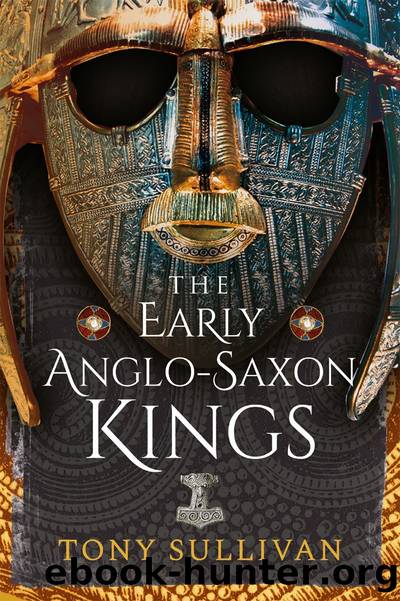The Early Anglo-Saxon Kings by Tony Sullivan

Author:Tony Sullivan [Sullivan, Tony]
Language: eng
Format: epub
ISBN: 9781399084178
Google: fXFBzwEACAAJ
Amazon: 1399084178
Publisher: Pen & Sword
Published: 2023-03-02T21:00:00+00:00
Weapons and armour
The most common weapons in the fifth and sixth centuries were the spear and shield. Spear shafts and heads came in different sizes and styles. Angular cutting blades, up to 50cm in length, and long shafts suggest they may have been used two-handed, indeed a Pictish relief shows just that.30 Shorter, barbed-headed spears, known as âAngonsâ, and the injuries they caused, are described by a sixth-century source.31 When embedded in flesh, the head cannot be pulled out without terrible pain and serious injury or death. The barb and iron cover near the head are difficult to cut off if it penetrates a shield. The attacker can tread on the shaft pulling the opponentâs shield towards the ground. The range of shorter spears or javelins was around 12â15m.32 To pierce armour a heavy shaft is required and a needle-shaped head similar to a bodkin-type arrow head.
Missile weapons became more important and we see an increase in light troops and mounted archers in the fifth century.33 Literary and artistic sources regularly depict archery, yet archaeological finds are rare in Britain. Germanic bows were âlongbowsâ made from a single piece of wood, in contrast to composite Asiatic bows. A good example of these were found in Nydham, Denmark. Forty bows, 6ft in length with shafts 74 to 94cm and leaf-shaped or barbed arrowheads. The maximum range was about 150â200m, but they tended to be effective from about 100m with accuracy at 50â60m.34 Archers, whether mounted or on foot, would have carried thirty to forty arrows.35
Throwing axes, francesca, were also popular and despite their name were used by other Germanic tribes with examples found in Britain. Procopius and Gregory of Tours both describe these short-handled axes being thrown prior to a charge. They had a range of 12m. These differed from the normal axes used in day-to-day work, or the longer axe hammer found at Sutton Hoo, with a shaft of 78cm. They are rarely found in graves or mentioned in the sagas for this period.36 In terms of missiles, an attacking force might expect arrows, spears and finally throwing axes aside from slings and throwing darts.
At close quarters the seax was a single-edged blade ranging from 8â31cm. Longer examples of 54â76cm are not found until the later eighth century.37 Thus a warrior of our period would have had the shorter version, at up to a foot long, carried horizontally on his belt. The blade would not have been suited to piercing mail. Some warriors would have carried a sword, although there is some debate as to how common this was.
Less than one in twenty grave finds contained swords, the majority containing spears;38 22 per cent of graves in Kent contained swords, yet only 3 per cent of Anglian graves further north did so.39 In the West Saxon area of Abingdon in Berkshire, only two swords have been found in eighty-two cremations and 119 burials. Of course there may have been cultural difference and some groups may have been reluctant to dispose
Download
This site does not store any files on its server. We only index and link to content provided by other sites. Please contact the content providers to delete copyright contents if any and email us, we'll remove relevant links or contents immediately.
Room 212 by Kate Stewart(4155)
The Crown by Robert Lacey(4143)
Endurance: Shackleton's Incredible Voyage by Alfred Lansing(3893)
The Iron Duke by The Iron Duke(3680)
The Rape of Nanking by Iris Chang(3569)
Killing England by Bill O'Reilly(3491)
Joan of Arc by Mary Gordon(3302)
Say Nothing by Patrick Radden Keefe(3107)
I'll Give You the Sun by Jandy Nelson(2872)
Shadow of Night by Deborah Harkness(2787)
Hitler's Monsters by Eric Kurlander(2768)
Margaret Thatcher: The Autobiography by Thatcher Margaret(2710)
Mary, Queen of Scots, and the Murder of Lord Darnley by Alison Weir(2700)
Darkest Hour by Anthony McCarten(2679)
Blood and Sand by Alex Von Tunzelmann(2635)
Red Famine: Stalin's War on Ukraine by Anne Applebaum(2497)
Eleanor & Park by Rainbow Rowell(2432)
The One Memory of Flora Banks by Emily Barr(2382)
Book of Life by Deborah Harkness(2311)
